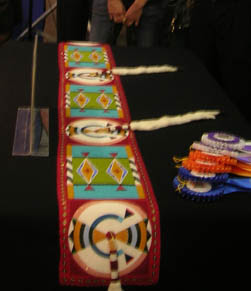We couldn't photograph them all. Here is a random selection of the top winners. (And, at the end, a look at the crowds and booths that fill the streets and plaza of Santa Fe for two days of Indian Market.)













Bringing you news and insights about Tribal Art, its creators and its collectors.
















 Please note that the last photo, which shows Jamie's award-winning blanket on display in her Indian Market Booth, includes a photo from the Albuquerque Journal featuring Jamie's blanket being worn by her. Look closely at the photo in the newspaper and you will see yours truly, William Waites, standing in the background. (Proof that I was there?)
Please note that the last photo, which shows Jamie's award-winning blanket on display in her Indian Market Booth, includes a photo from the Albuquerque Journal featuring Jamie's blanket being worn by her. Look closely at the photo in the newspaper and you will see yours truly, William Waites, standing in the background. (Proof that I was there?)









 Here we have the front and back views of a particularly complex young woman's outfit
Here we have the front and back views of a particularly complex young woman's outfit




 And, of course, every competition must have a "Best of Show" award. Here they are.
And, of course, every competition must have a "Best of Show" award. Here they are.
 IAIA Distinguished Alumni - America Meredith (Cherokee),
IAIA Distinguished Alumni - America Meredith (Cherokee), Jewelry - Ric Charlie (Navajo),
Jewelry - Ric Charlie (Navajo), Pottery - Rainy Naha (Hopi).
Pottery - Rainy Naha (Hopi).
 Painting, etc - William B. Franklin - Navajo,
Painting, etc - William B. Franklin - Navajo, Wooden Pueblo Carvings - Kevin Sekakuku (Hopi),
Wooden Pueblo Carvings - Kevin Sekakuku (Hopi), Beadwork/Quill Work - Dallin Maybee (Seneca/Northern Arapaho),
Beadwork/Quill Work - Dallin Maybee (Seneca/Northern Arapaho), (L-R) Ric Charlie, Melissa Darden, Dallin Maybee, Jamie Okuma, Chris Youngblood Cutler, America Meredith
(L-R) Ric Charlie, Melissa Darden, Dallin Maybee, Jamie Okuma, Chris Youngblood Cutler, America Meredith

 Kevin Soseeah
Kevin Soseeah Leland Boone
Leland Boone Michael Mahooty
Michael Mahooty Pernell Laate
Pernell Laate Tyrone Poncho
Tyrone Poncho